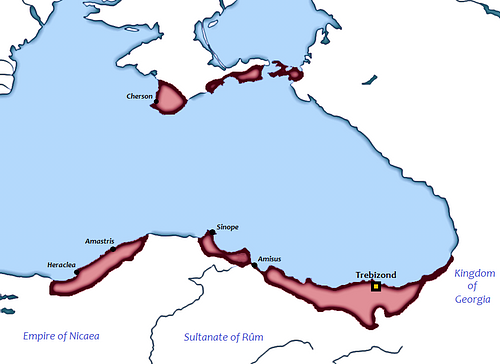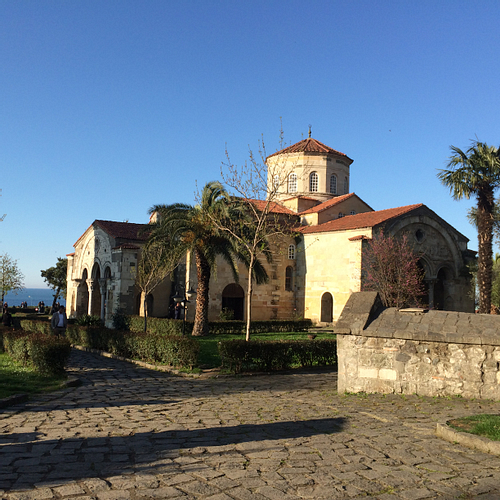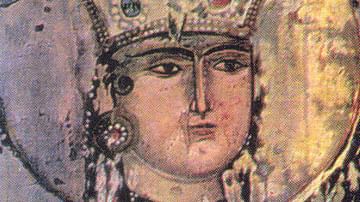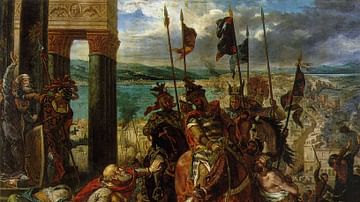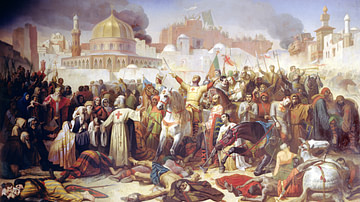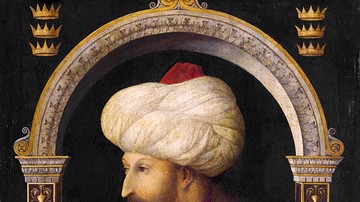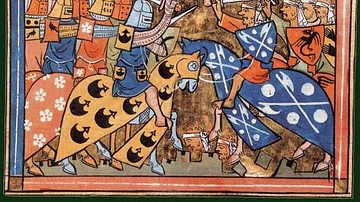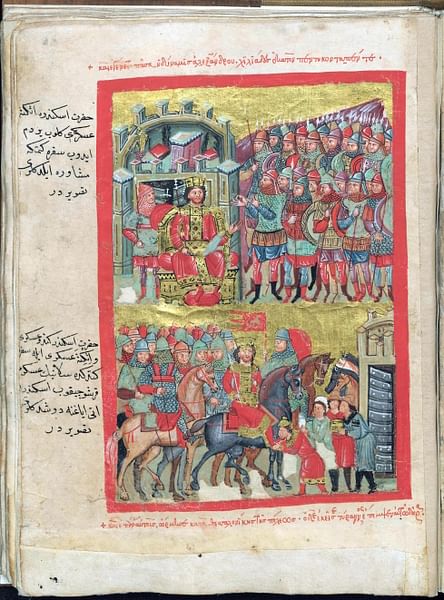
The Empire of Trebizond was an offshoot of the Byzantine Empire that existed from 1204 to 1461 CE, ruled by the Megas Komnenos Dynasty, descendants of the Komenos Byzantine emperors. The Empire of Trebizond has been far less researched than the Byzantine Empire, let alone the Roman Empire, yet it was the last real surviving descendant of those empires. Famed for its lucrative trade and beautiful princesses, Trebizond was at the edge of the medieval world, located on the southern side of the Black Sea surrounded by powerful empires.
Origins of an Empire
Following the murder of Byzantine emperor Andronikos I Komnenos in Constantinople in 1185 CE, the rest of the Komnenos family was hunted down in an orgy of blood. The sole survivors were the small boys Alexios and David, grandsons of Andronikos I, who were smuggled out of the city and to the safety of their relative, Queen Tamar of Georgia.
In 1204 CE, the brothers, now in their twenties, decided to take advantage of the chaos in Constantinople and make their move. Byzantine Emperor Alexios III Angelos had fled Constantinople in 1203 CE and the army of the Fourth Crusade that placed Alexios IV Angelos on the throne in his place was now camped outside the city gates, waiting for the promised bounty of gold from the new emperor. By the end of 1204 CE, Constantinople would be sacked for the first time in its history and the Byzantine Empire would be shattered and banished from the “Queen of Cities” for nearly 60 years.
Alexios and David marched into the eastern part of the Byzantine Empire with Georgian troops from their relative Tamar and captured the port city of Trebizond on the Black Sea and the surrounding province of Chaldia. Trebizond had a long history as a semi-autonomous Byzantine city under the Gabras family dating back to the end of the 11th century CE. It was the most significant Byzantine port on the southern coast of the Black Sea and was a major hub for trade. In his new capital of Trebizond, Alexios declared himself Emperor Alexios I Megas Komnenos (“Great” Komennos, r. 1204-1222 CE).
Imperial Pretentions
Alexios did not stop with merely being the lord of Trebizond, however, and declared himself Emperor and Autocrat of the Romans (i.e. the Byzantines). His brother David marched their army west, capturing territory along the Black Sea coast and advancing closer to Constantinople. The greatest prize taken was the prominent port city of Sinope, the former capital of the ancient Kingdom of Pontus. But in 1214 CE the Trapezuntine army suffered a serious reversal and was crushed by the Empire of Nicaea, one of the three Greek successor states that emerged after the Fourth Crusade had sacked Constantinople. Later that year the Seljuk Turks captured Sinope from the Trapezuntines, effectively demarcating the furthest extent west of the empire of Alexios I and his descendants.
Alexios and his successors maintained their claim on the throne of Constantinople, but geographically cut off, if anyone was going to reconquer Constantinople from the Latins that now occupied it, it would be the much closer Empire of Nicaea or the Despotate of Epiros, the third Byzantine Greek successor state. The Empire of Nicaea achieved the reestablishment of the Byzantine Empire with Constantinople's reconquest in 1261 CE, and in 1282 CE, John II Megas Komenos (r. 1280-1297 CE) formally renounced his imperial pretensions.
Although John II had given up his Byzantine imperial claims, his successors still continued to call themselves emperors until the end of the empire. But unlike the Roman or Byzantine Empires, there were no great periods of territorial expansion or contraction for the Empire of Trebizond. The state's borders were effectively set in 1214 CE. The Empire of Trebizond was comprised of the eastern half of the Anatolian Black Sea coast, in Chaldea and Pontus, as well as a loose control over the former Byzantine territories in the Crimea, although that relationship was never very strong. Trebizond was made a Constantinople in miniature, replete with its own Hagia Sophia.
Settling Down & Mongol Help
Being an empire in name only, the Empire of Trebizond needed to establish itself on the world stage to survive. It was surrounded by powerful states such as the Seljuk Turks and the Italian maritime republics of Genoa and Venice. In the beginning, Trebizond benefited enormously from the assistance of Queen Tamar of Georgia, the greatest of medieval Georgian rulers, but then the Mongols crushed her descendants in the 1220s CE. The Mongols returned and crushed the Seljuk Turks in the early 1240s CE, effectively removing them from the map. At the same time, Manuel I Megas Komennos (r. 1238-1263 CE) recaptured Sinope in 1254 CE, although it would be lost by the end of the 13th century CE.
Through luck and diplomacy, the Empire of Trebizond benefitted enormously from the advent of the Mongols in the region. Although the Mongols greatly weakened Georgia, they destroyed the Seljuk Turks and, by sacking Baghdad in 1258 CE, diverted the terminus of the Silk Road to Trebizond. With this came the wealth and prestige of being a funnel of trade between East and West. Even Marco Polo went through the city on his return from China.
The Mongol Empire was a valuable patron of Trebizond. Wealth from the Silk Road poured into the city and any enemy would think twice before messing with the Mongol army, the most powerful military juggernaut the world had yet seen.
The realignment of the Silk Road made Trebizond extremely wealthy and it carried on a prosperous trading relationship with the Italian maritime republics. However, like the Byzantine emperors in Constantinople, the relationship with the Venetians and Genoese was at times quite contentious and the two Italian cities forcibly established trading colonies in the city.
Internal Divisions
The 14th century CE started off well for the Trapezunites. Alexios II Megas Komnenos (r. 1297-1330 CE) achieved the furthest southern expansion of the Empire of Trebizond to the city of Erzurum briefly in the 1310s CE. Alexios' long reign allowed stability to take advantage of the wealth from trade and to expand Trebizond's influence.
Following Alexios' death, the empire descended into over a decade of civil war. This civil war had everything: child emperors, scheming empresses, fratricide, and seven emperors between 1330 and 1349 CE. The real civil war emerged in 1340 CE, when Irene Palaiologina (r. 1340-1341 CE), the widow of the previous emperor and the illegitimate daughter of Byzantine Emperor Andronikos III Palaiologos (r. 1328-1341 CE), took power after possibly killing her husband. The noble Amytzantarioi family, Byzantine mercenaries, and the Genoese supported Irene. Opposing her were the aristocratic Scholaroi family, who represented most of the local nobility in the Empire of Trebizond.
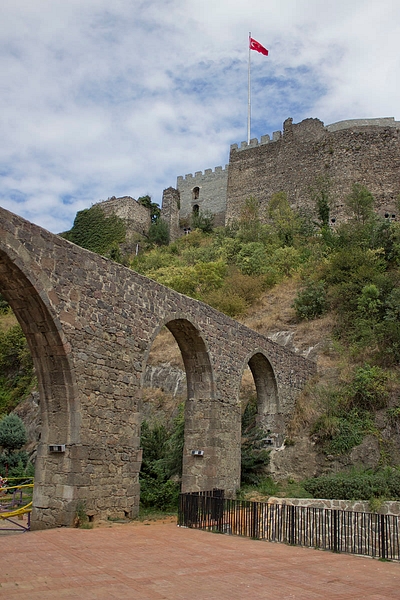
Irene was initially triumphant, but then Alexios II's daughter, Anna Anachoutlou (r. 1341-1342 CE), left her nunnery and gained the support of the local Laz population, overthrowing Irene. This led to a reshuffling of factions: the Amytzantarioi supported Anna and the Scholaroi opted instead for a Byzantine alliance, bringing in John III Megas Komnenos (r. 1342-1344 CE) to replace Anna. John was later replaced by Michael I Megas Komenos (r. 1344-1349 CE), by which point the parties had coalesced into Greek noble (Scholaroi) and local Laz (Amytzantarioi) parties. Naturally, the conflict involved copious amounts of bloodshed on both sides.
Trebizond's enemies naturally took advantage of this internal unrest. Genoa seized the city of Kerasus and the Turks conquered some border territory and even besieged Trebizond. On top of this, the Black Death ravaged the Trapezuntine population. At the end of 1349 CE, Michael was deposed and thus began the long reign of Alexios III Megas Komnenos (r. 1349-1390 CE).
Golden Age of Trebizond
Despite the ravages of the previous decade, Trebizond rebounded during the reign of Alexios III. It maintained its position as a major trade center and the wealth that came along with it. The Empire of Trebizond also gained its reputation for superb diplomacy during this time. Trapezuntine diplomats fostered close relations with the Byzantines and the White Sheep, a major nomadic Turkish confederacy bordering the empire. At the same time, they played the Genoese and Venetians off against each other.
It was also during Alexios III's reign that the Empire of Trebizond became known for its practice of marrying imperial brides off to its neighbors. The imperial Trapezuntine princesses were famously beautiful and came with large dowries. Their hands stayed the wrath of enemies from Constantinople to Persia.
Even the rise of the Ottoman Empire did not seem to stop the empire. Being ever the crafty diplomat, the Empire of Trebizond allied itself with the Turko-Mongol warlord Tamerlane, who trounced the Ottomans at the Battle of Ankara in 1402 CE and took the Ottoman sultan Bayezit I (r. 1389-1402 CE) captive in a golden cage.
Their Days Were Numbered
But the Ottoman Empire did not fall. Once Tamerlane left, the Ottomans regrouped and established just as powerful of a state as had existed before the Battle of Ankara. The Trapezuntines continued their marriage alliances, marrying off imperial princesses to the powerful White Sheep and Black Sheep Turkmen confederacies and the Byzantine Empire. They also included the Turkish kingdoms of Sinope and Karamania, as well as Georgia, in a massive coalition against the Ottomans.
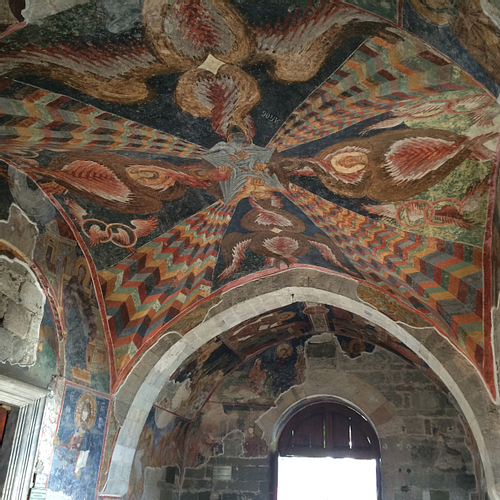
Despite these attempts to thwart the Ottoman advance, it soon became clear that conquest would be inevitable. The Ottomans besieged Trebizond in 1442 CE and again in 1456 CE, forcing the Trapezuntines to pay tribute. In the meantime, the Ottomans were absorbing the other remnants of the once glorious Byzantine Empire. Constantinople fell in 1453 CE and the independent Peloponnese in mainland Greece fell in 1460 CE.
The final straw for the Ottoman Sultan Mehmed II (r. 1451-1481 CE) was David Megas Komnenos (r. 1460-1461 CE) intriguing with European powers to invade the Ottoman Empire in a crusade. In just one month, the Ottomans conquered Trebizond and ended the last real descendant of the Byzantine Empire. The offshoot of Trebizond in the Crimea would still survive until 1475 CE, when the Ottomans conquered it too.
Legacy of Trebizond
Trebizond was not the biggest or strongest of the Byzantine successor states, but it was the longest lasting. It survived Epiros, the Peloponnese, and even the restored Byzantine Empire. Seljuks, Mongols, and dozens of Turkish states rose and fell around it over the decades.
The Empire of Trebizond was a cultural and economic hub for centuries and its legacy still survives today in the modern Turkish city of Trabzon. The Hagia Sophia still stands. It was converted into a mosque following Mehmed II's conquest of the city, but today some of the mosaics are restored. Other Megas Komnenos-era churches still stand as well. The city walls built under the Trapezuntine emperors are still as formidable today as they were centuries ago.
In terms of population, the existence of the Empire of Trebizond helped preserve the Greek identity in the Pontus region up until the 20th century CE. The local Laz people have also survived the centuries and still live in northeast Turkey today.
